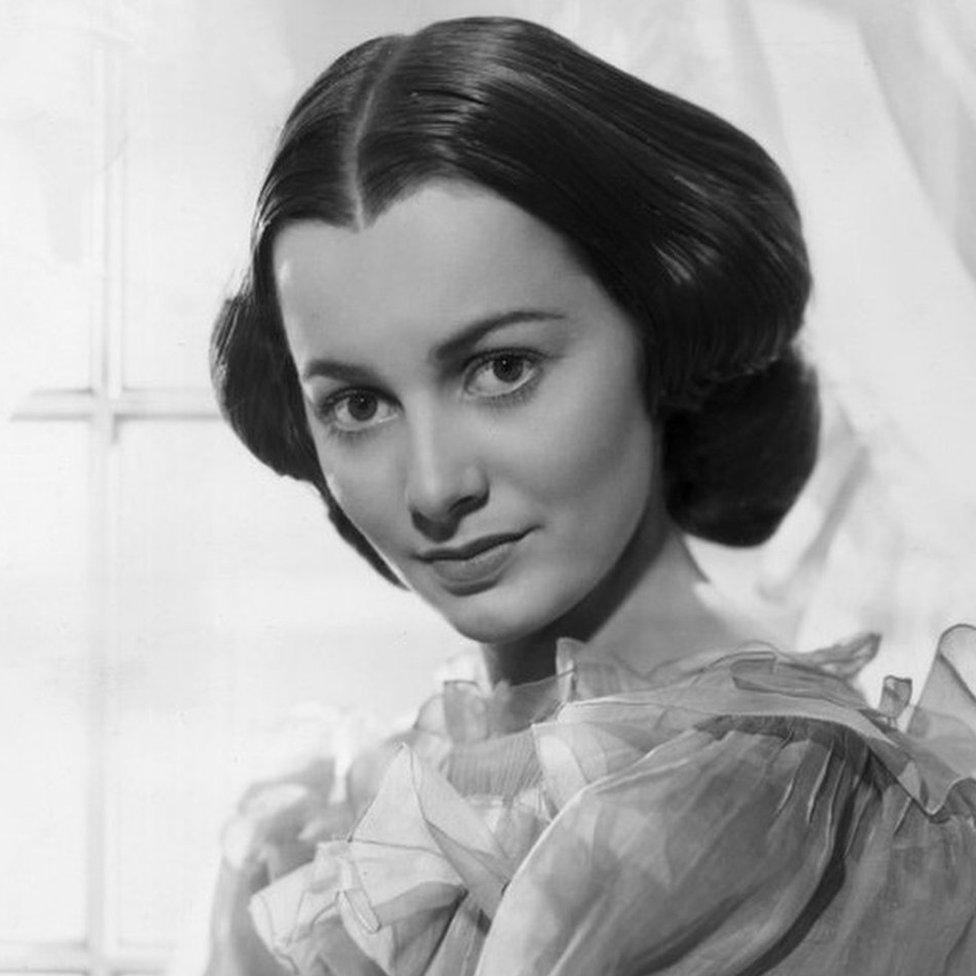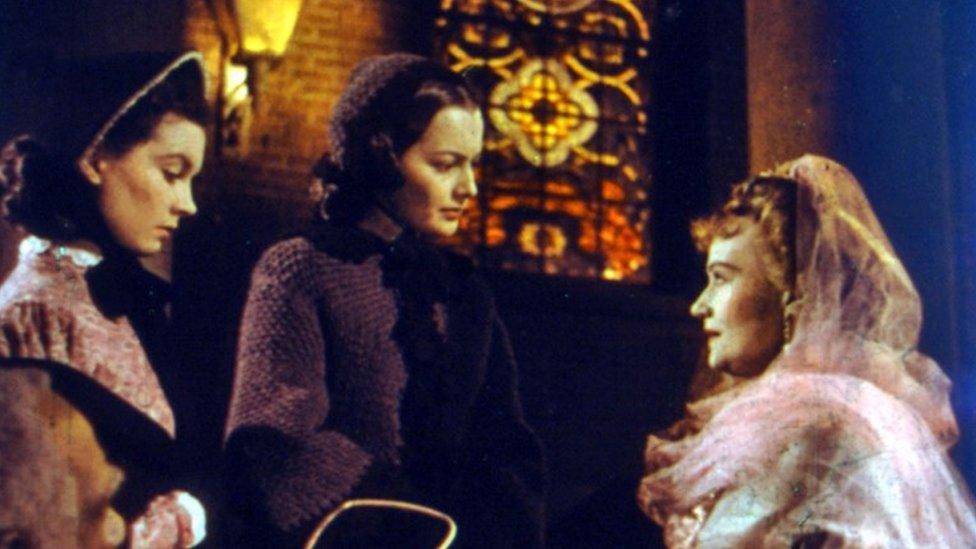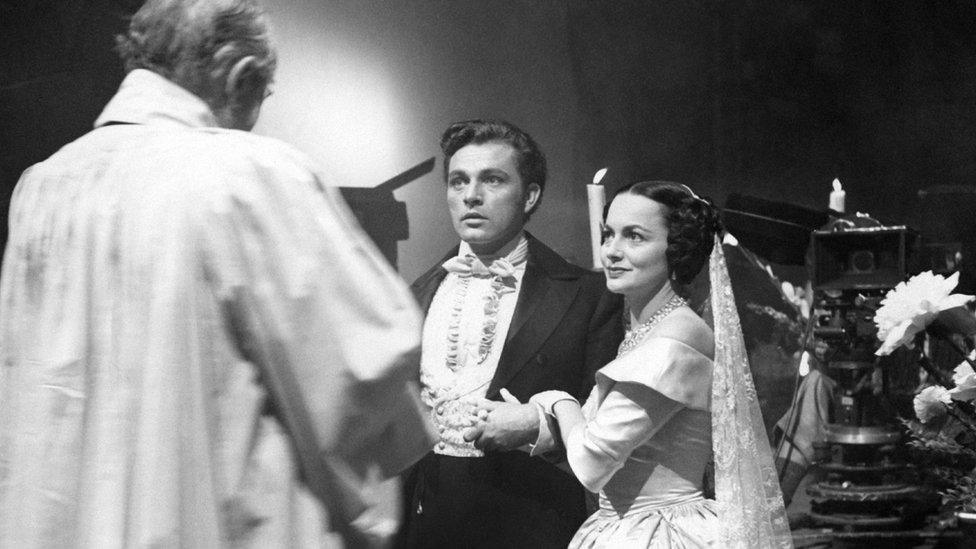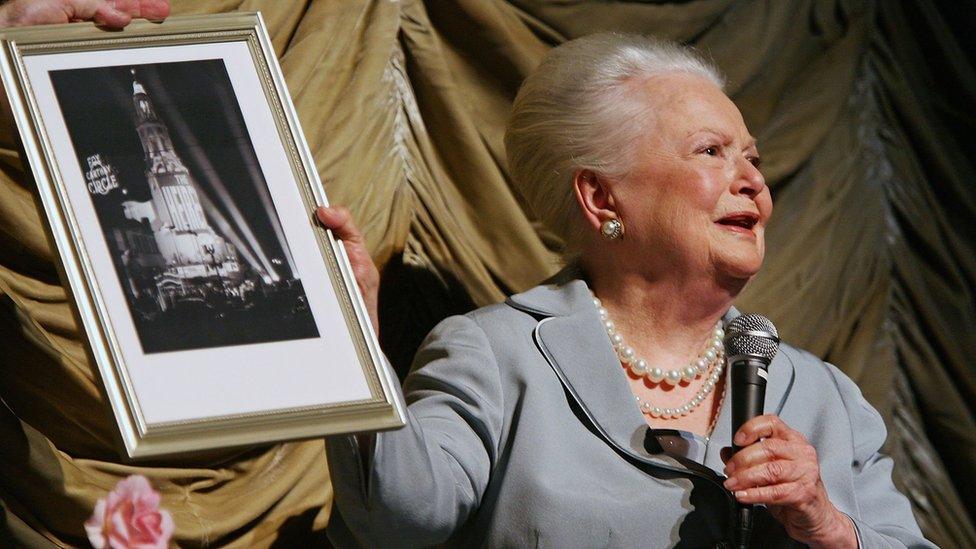Obituary: Olivia de Havilland, star of Hollywood's Golden Age
- Published


Dame Olivia de Havilland, who has died at 104 in Paris, was one of the last survivors of Hollywood's Golden Age.
Her most famous role was that of the virtuous Melanie opposite Vivien Leigh's wayward Scarlett, in the epic Gone with the Wind.
Her relationship with her sister, the actress Joan Fontaine, was a constant source of speculation in the gossip columns.
At the time of her death she was the oldest living performer to have won an Oscar.
Olivia Mary de Havilland was born in Tokyo on 1 July 1916 to Walter, a British patent lawyer and his actress wife Lilian.
Her paternal family originated in the Channel Islands; her cousin Geoffrey was the aircraft designer responsible for producing the famous World War Two plane, the Mosquito.
Her sister Joan was born in 1917. Both girls suffered from bronchial problems and her mother moved the family to California in 1919 in search of a more agreeable climate.
De Havilland's father, who was notorious for his infidelities, soon abandoned them to return to Tokyo where he later married his Japanese housekeeper.

Many of her earlier films failed to properly showcase her talent

Lilian gave elocution and singing lessons to her two daughters and introduced them to the works of Shakespeare.
In 1925 her mother married a department store owner, George M Fontaine, who imposed a strict regime on his two stepdaughters.
By this time the sisters had embarked on what would become their legendary feud, caused - according to their biographer Charles Higham - by Olivia's inability to accept a younger sibling.
For her part, Joan thought her mother favoured Olivia, who Higham said enjoyed cutting up Joan's clothes and forcing her to sew them back together again.
Chemistry
De Havilland was bitten by the drama bug while at Los Gatos High School, making her stage debut in 1933 in an amateur production of Alice in Wonderland.
She later recalled: "I was actually moving in Alice's enchanted wonderland. And so, for the first time, I felt not only pleasure in acting but love for acting as well."
She was spotted by director Max Reinhardt, who cast her as Hermia in a production of a Midsummer Night's Dream at the Hollywood Bowl. She made her screen debut when the play was filmed for Warner Brothers in 1935. It received lukewarm reviews.
Her breakthrough came when producer Hal Wallis persuaded the studio to cast her in Captain Blood, opposite an Australian actor named Errol Flynn.

There was a definite chemistry between de Havilland and Errol Flynn

The chemistry between the pair was immediate and they would star together in another seven films, including The Charge of the Light Brigade and The Adventures of Robin Hood.
De Havilland later claimed that Flynn, who had a reputation as a womaniser, had proposed to her but she had turned him down as he was already married.
Throughout the 1930s she appeared in a number of light, romantic films that allowed her to showcase her perfect diction but did little to advance her career,
"Playing good girls in the 30s was difficult when the fad was to play bad girls," she said.
With the support of Jack Warner's wife, Ann, de Havilland was offered the role of Melanie in David O Selznick's epic adaptation of the Margaret Mitchell novel, Gone With the Wind.
Hampered
She received much critical acclaim for her performance and was nominated for an Oscar for best supporting actress. She lost out to Hattie McDaniel who played Mammy, making her the first African-American actress to win an Academy Award.
De Havilland's feud with her sister showed little sign of abating. When Fontaine won a best actress Oscar in 1942, she allegedly refused to acknowledge De Havilland, who had also been nominated, although Fontaine later denied this.
Some commentators suggested the pair maintained the pretence of an ongoing quarrel and pointed out that the sisters did meet often on social occasions.

There was an Oscar nomination for her role in Gone With the Wind

De Havilland's efforts to continue to play more serious roles were hampered by Warner Brothers which, like all major studios at the time, had complete control over its stars.
When she was told Warner was adding time to her original contract as a penalty for turning down roles, she took the studio to court with the support of the Screen Actors Guild.

Olivia de Havilland and Richard Burton starred in My Cousin Rachel
The California Supreme Court ruled in her favour in what became known as the De Havilland Law, which loosened the grip studios had on their actors.
"I was told I would never work again, if I lost or won," she later said. "When I won, they were impressed and didn't bear a grudge." However, De Havilland did not make another film for more than two years.
Honours
Subsequently her career flourished. She won an Oscar in 1946 for her role in To Each His Own, the same year in which she married a naval veteran named Marcus Goodrich. She went on to major dramatic roles in The Snake Pit in 1948 and in The Heiress a year later, for which she won a second Oscar.
In the 1950s she moved to France with her second husband, Frenchman Pierre Galante, the editor of Paris Match, and devoted most of her time to a growing family.
She famously turned down the role of Blanche DuBois in the 1951 adaptation of A Streetcar Named Desire. Instead the part went to Vivien Leigh, who won an Oscar.
There was a Golden Globe nomination for her role in an adaptation of My Cousin Rachel opposite Richard Burton and she won much praise for Lady in a Cage, a 1964 film in which she played a crippled widow trapped in a lift by intruders.

She continued to act sporadically until the late 1980s, winning a Golden Globe in 1986 for Anastasia: The Mystery of Anna.
In 2008, at the age of 92, de Havilland received the US National Medal of Arts from George W Bush. Two years later she was awarded the Knight Legion of Honour from French President Nicolas Sarkozy. She had been a French resident for more than 50 years.

Holding a picture from The Heiress for which she won an Oscar
The feud with Fontaine, which had been reignited over quarrels about medical treatment for their mother in 1975, finally ended with Fontaine's death in 2013.
Fontaine had been quoted as saying: "I married first, won the Oscar before Olivia did, and if I die first, she'll undoubtedly be livid because I beat her to it."
De Havilland issued a statement saying she was "shocked and saddened" by her sister's death.
She was created a Dame in the 2017 Birthday Honours list, within weeks of her 101st birthday, making her the oldest person to receive the award. She described it as "the most gratifying of birthday presents".
Unable to travel to London for the investiture, she received her honour in Paris , externalin 2018 from the British ambassador to France.
Guarded reputation
Also in 2018, de Havilland began legal proceedings against the FX TV network over how she was depicted in their docudrama Feud: Bette and Joan.
The show, starring Susan Sarandon and Jessica Lange, depicted the conflict between Bette Davis and Joan Crawford on the film Baby Jane. Catherine Zeta Jones played de Havilland in the role of narrator.
De Havilland's attorneys said: "Miss de Havilland was not asked by FX for permission to use her name and identity and was not compensated for such use.


"Further, the FX series puts words in the mouth of Miss de Havilland which are inaccurate and contrary to the reputation she has built over an 80-year professional life. Specifically, refusing to engage in gossip mongering about other actors in order to generate media attention for herself."
But the California appeals court ruled against her. Further appeals to the California Supreme Court also came to a dead end.
Olivia de Havilland began her film career when black and white still held sway over colour and Hollywood studio bosses ruled their stars with a rod of iron.
The last of the major players in Gone With the Wind, she admitted in a 2015 interview that she still watched the film from time to time in order to connect with her former co-stars.
"Luckily it does not make me melancholy," she said. "Instead, when I see them vibrantly alive on screen, I experience a kind of reunion with them, a joyful one."